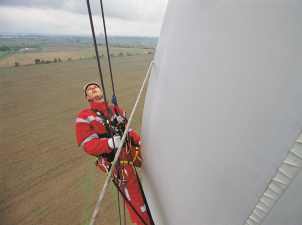Wind-energy production has more than doubled — from 150 terawatt-hours in 2010 to 364 terawatt-hours in 2017 — and now makes up more than 11 percent of the European Union’s electricity, according to a report by Agora Energiewende and Sandbag. Germany now generates so much wind power — more than 106 terawatt-hours in 2017 — that on blustery days in the north, high-voltage transmission lines carrying all that power to the southern part of the country sometimes have to divert excess electricity to neighboring countries.
All these wind farms also need tending. As turbines age, so do their blades. Some of Europe’s turbines have been operating nearly 24 hours a day for 18 years. Their slender blades — some are as long as the wingspan of a jumbo jet — are under considerable stress from wind, sea, rain, sunlight, lightning and freezing winters as they rotate and generate electricity. Identifying problems in blades early is vital for operators and owners to keep costs down and assets running.
No wonder that maintaining these blades is now a growth industry in Europe. LM Wind Power, a GE Renewable Energy subsidiary that manufactures turbine blades, has hundreds of thousands of blades working on about 90,000 turbines globally, including 35,000 or so made for GE turbines. “Europe was one of the first regions that aggressively adopted wind energy,” says Anne McEntee, CEO of GE Renewable Energy Digital Services. “How you take care of the installed base is very important. Customers have the best wind locations, and they want to extend the life of their farms.”
The holy grail of maintenance is spotting small flaws in turbine blades before they become big, costly ones. The blades are made from composites — handmade materials assembled from alternating layers of fiberglass, balsa wood and resin. Over time, these composites can develop minute imperfections that can, if left untreated, disturb the airflow over the blades and degrade their performance. Big repairs that require the removal of the blade from the turbine are often logistical headaches resulting in significant expenses for wind-farm operators. They’re also complicated endeavors, requiring skilled technicians on cranes or ropes, and they can take a turbine out of commission for weeks or months.
Top and above: Blade inspection sometimes requires deft use of ropes and harnesses. For this reason, a disproportionate share of the 250 repair technicians at LM Wind Power are mountain climbers in their leisure time. Images credit: LM Wind Power.
But finding flaws early isn’t easy — they often hide inside the blades themselves, invisible on the surface. One approach used by GE Renewable Energy employs thermographic cameras that can sense the heat from the friction between the fiberglass layers occurring when a flaw has developed deep inside a blade. The company is also developing acoustic sensors, which use sound waves to detect flaws. “The thing I love about this technology is that it can detect indications of wear below the surface,” says Veronica Barner, productivity services leader at GE Renewable Energy. “That’s where defects start to propagate.”
The data from the measurement feeds machine-learning algorithms that help engineers assess the severity of the flaw and prioritize repair. A cosmetic flaw would be a category 1; a large crack on the verge of catastrophic failure would be a category 5. Repair costs rise dramatically with the severity of the flaw: A category 4 flaw costs on average six times what a category 2 repair costs, and a category 5 repair costs 12 times a category 3. “You never want to replace your blades, because they’re huge, and it often requires using cranes to remove them for repair/replacement, which is very expensive and labor-intensive,” McEntee says. “So it’s important to maintain them well and address issues as early as possible.”
Naturally, LM Wind Power technicians aim to find flaws early and fix the blades while they’re still attached to the turbines. Usually this is done from a platform, but sometimes it requires deft use of ropes and harnesses. For this reason, a disproportionate share of the 250 repair technicians at LM Wind Power are mountain climbers in their leisure time.
Once the technicians reach the place on the blade that needs repair, they grind down the area of the blade around the flaw and rebuild it on the spot — adding alternating layers of fiberglass and resin by hand, and sculpting the final shape to make the flow of air over the blade as efficient as possible. “Composite materials are very, very strong if you use them right, but they’re brittle if you don’t,” says Fred Maenhaut, general manager for LM Wind Power Blade Service.
“Our repair methods require a background in blade design,” Maenhaut says. “You need to know how many layers of fiberglass and resin to build up. People who do the repair are a team of blade engineers and technicians. We get a lot of our talent from LM Wind Power’s factories and support our customers worldwide with the same standards from eight regional hubs.”
28 Декабря 2025 | воскресенье | 23:42


